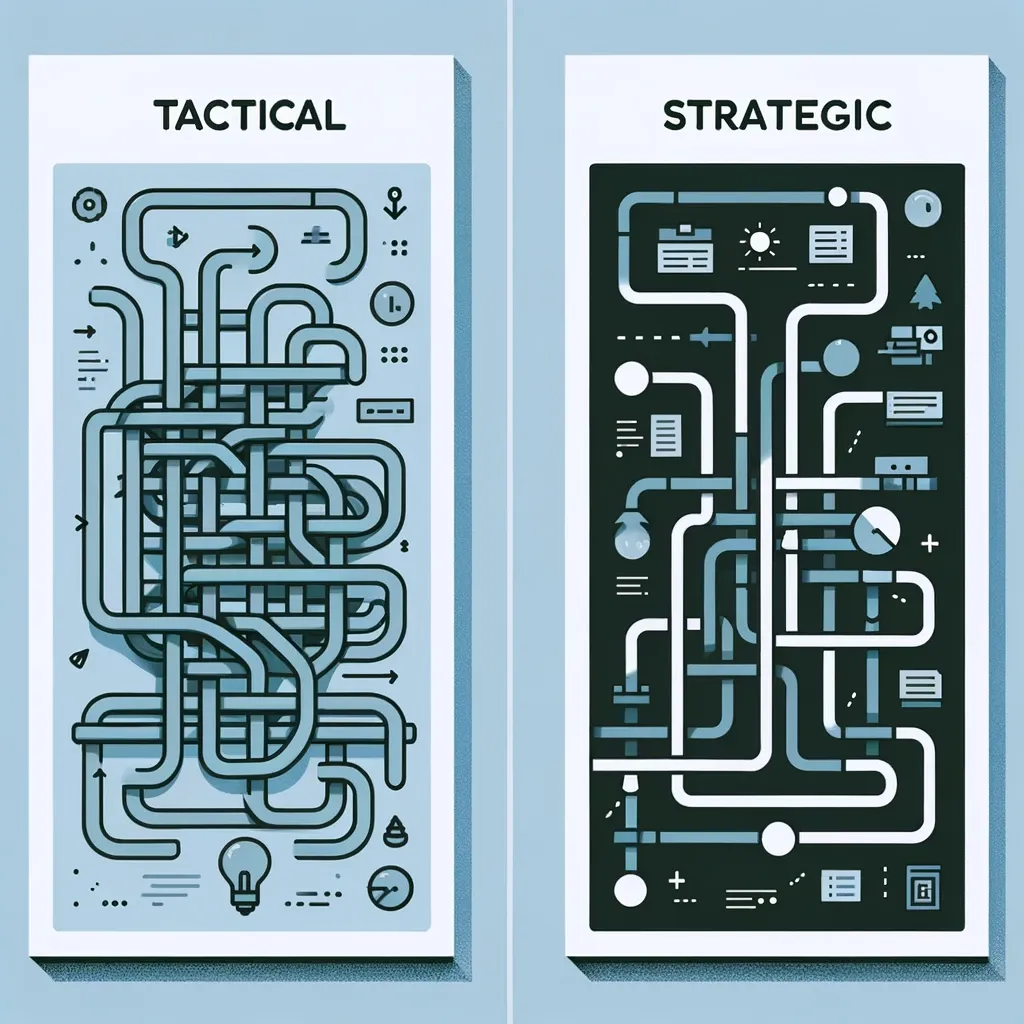Insights on "A Philosophy of Software Design" by John Ousterhout
- What are the Secrets of Software Design?
- Magic Trick: Red Flags
- Minimize Complexity: Deep Classes and Information Hiding
- Define errors out of existence
- Mindset: Tactical vs. Strategic programming
- How much to invest?
- New ideas discovered
- Key Lessons and Conclusion
Have you ever wondered what constitutes good software design? John Ousterhout points out that there’s no universal agreement on this.
What then is the most pivotal idea or concept in all of computer science? Here are some options, and feel free to add your own before proceeding:
- Abstraction
- Testing
- Composition
- Complexity
- Layers of Abstraction - by Dan Canough
Consider your own approach to complex problems: Professor Ousterhout suggests that the key lies in Problem Decomposition, which involves dividing a complex problem into more manageable pieces.
Complexity is the primary problem, and our main task is to minimize it.
This concept is crucial, yet it is not sufficiently taught. How can we effectively teach this, so anyone can become a better developer? The answer lies in practice.
As a developer, what do you think is the best way to practice and enhance your skills?
Iteration. Write. Review. Rewrite. Restart.
In his video, which is linked at the end, Professor Ousterhout provides a detailed overview of his teaching process. However, this article focuses on his software design ideas.

What are the Secrets of Software Design?
- Magic Trick: Red Flags
- Minimize Complexity: Deep Classes and Information Hiding
- Define Errors Out of Existence
- Mindset: Tactical vs. Strategic Programming
Magic Trick: Red Flags
The principles above are abstract, especially for beginners. If unsure about good design, use red flags as a guide. When you spot bad code and manage to move away from it, you likely end up in a better position than before.
Even if Professor Ousterhout doesn’t talk about specific red flags in his video, I’ll share some of them from his book:
- Shallow Module (class, function, etc.) when the is interface is more complex than the implementation.
- Information Leakage when the same knowledge is repeated in multiple places.
- Temporal Decomposition when the structure of the code reflects the execution order.
- Overexposure when the API forces the user to learn about other rarely used features.
- Pass-through Methods when a method just calls another method without adding any value.
- Repetition when the same code is repeated in multiple places.
- Special-General Mixture when a general-purpose module contains special-purpose code.
- Conjoined Methods when to understand a method you need to understand another method.
- Comment Repeats Code when the comment repeats the code.
- Implementation Documentation Contaminates Interface when the implementation details are exposed in the interface documentation.
- Vague Name when a variable, function, or class name is broad enough to refer to multiple things.
- Hard to Pick Name when it’s hard to pick a name for a variable, function, or class, it’s a hint that the design is not good.
- Hard to Describe when it’s hard to describe what a variable, function, or class does, that an indicator that there might be a problem with the design.
- Nonobvious Code if the meaning and behavior of code cannot be understood with a quick reading.

Minimize Complexity: Deep Classes and Information Hiding
The principle of information hiding, first introduced by David Parnas in his paper “On the Criteria to be Used in Decomposing Systems into Modules,” is pivotal in software design. We’ll examine this concept through the lens of ‘deep classes.’
Imagine a class as a rectangle, divided into two sections. The upper section symbolizes the interface, encompassing all the knowledge necessary to use the class, including public methods, side effects, performance implications, dependencies, and other behaviors that might affect how the class is used. This segment represents the ‘complexity cost.’
The lower section of the rectangle embodies the class implementation.
The goal is to achieve maximum functionality with minimal complexity cost, which means a streamlined interface that masks a wealth of functionality.
In contrast, consider a ‘Shallow Class.’ This exaggerated example illustrates its limited utility:
private void addNullValueForAttribute(String attribute) {
data.put(attribute, null);
} To use this method, one must grasp its entire implementation, which is trivial. Directly using the implementation is more straightforward:
data.put(attribute, null); A ‘Deep Class’ offers an elegant way of thinking about abstraction, presenting a simple interface while concealing complex operations beneath.
This concept is applicable not only to classes but also to methods, modules, and any construct with distinct interface and implementation layers.
However, it’s important to note that using Shallow Classes is not always wrong, they just offer limited design value. For example, consider a function designed to print INFO messages in a standardized format:
public void logInfo(String message) {
System.out.println("INFO: " + message);
}Another aspect to consider is the evolution of a class. If you have a good reason to believe that internal implementation will become more complicated in the near future, you could start with a shallow implementation. Just consider that the interface may also change as the implementation grows.
The complexity lies not in the number of lines but in the depth of understanding required to interact with the interface.
Have you encountered the issue of having too many, too small, too shallow classes in your own coding experience? The reason people do this is that they have been taught that classes and methods should be small. How many of you have heard of a number, like after N number of lines a method should be broken down?
What is the number you’ve heard?
- 20
- 10
- 4
- Others
This leads to Classitis,when someone says that classes are good, and thinks more classes are better.
Consider this Java example involving file and object stream reading:
FileInputStream fileStream = new FileInputStream(fileName);
BufferedInputStream bufferedStream = new BufferedInputStream(fileStream);
ObjectInputStream objectStream = new ObjectInputStream(bufferedStream);- 3 objects must be created and managed.
- Additional objects are needed for buffering.
- Exceptions must be caught for each stream.
- This introduces unnecessary complexity for a simple task.
Reading a file should be straightforward. The common case must be simple.
Instead of focusing on line count, aim for deep abstractions. If an abstraction is deep yet lengthy, consider splitting it, keeping depth as the priority.
For instance, consider the Unix file I/O system, comprising just five functions:
int open(const char* path, int flags, mode_t permissions);
int close(int fd);
ssize_t read(int fd, void* buffer, size_t count);
ssize_t write(int fd, const void* buffer, size_t count);
off_t lseek(int fd, off_t offset, int referencePosition);Beneath this straightforward interface lies a complex underpinning:
- On-disk representation and disk block allocation.
- Directory management and path lookup.
- Permission management.
- Disk scheduling.
- Block caching.
- Device independence.
In conclusion, strive to craft interfaces that are as simple as possible, regardless of the underlying complexity. This approach promotes efficient and intuitive design, essential for effective software development.

Define Errors Out of Existence
Errors are a significant source of complexity. The common wisdom is: detect and throw as many errors as possible.
-
For example, consider the TCL
unsetcommand. Professor Ousterhout who wrote it thought, “Why would anyone want to delete a variable that isn’t there?” So, he made it give an error in this situation. But it turns out, people often need to delete variables they’re not sure exist, like when stopping a task and cleaning up. The solution? Just let the command work without an error, because there’s no real difference if the variable wasn’t there in the first place. -
Another example is about deleting files. In an early Windows version, you couldn’t delete a file if it was open in another program. Even restarting the computer didn’t help if a background program was using it. Unix systems found a clever way around this. When you delete a file, Unix removes it from the folder but keeps the data for any program still using it. The system fully removes it only after all programs stop using it. This way, there are no errors for either side.
Of course, this doesn’t mean we should never throw errors. Sometimes they’re necessary, like when you try to read a file that doesn’t exist. But we should use error messages only when they’re really important.
In general, it’s better not to check for errors in every single operation. Catching syntax is clumsy while checking the return value is much simpler. But sometimes, you do need to throw an error. So, it’s important to think carefully about when it’s truly needed.

Mindset: Tactical vs. Strategic Programming
A tactical approach is straightforward: implement a feature or fix a bug doing the bare minimum to make it work and deliver it quickly. However, this approach often leads to a rapid increase in complexity and spaghetti code (makes me think of pasta 🍝). Over time, untangling this becomes increasingly difficult.
Conversely, the strategic approach embodies an investment mindset. It involves taking extra time today to benefit in the long run. Professor Ousterhout succinctly puts it: “The working code is not enough.” The aim should be to create a robust design that eases future development and reduces complexity.
Adopting a strategic programming style means starting slower but potentially speeding up later.
A note for beginners, particularly on learning projects: it’s acceptable to move quickly, even if your design isn’t perfect. At this stage, you might not fully grasp what constitutes good design, and that’s okay. In fact, I encourage rapid progress, as it allows for more iteration. The key lies in the mindset: if you recognize areas for improvement and know how to enhance them, then do so without excuses. Whether it’s renaming a function, reconsidering parameters, return values, or splitting functions, if you think it can be better, make it better. It might be challenging at first, but as you code more, learn more, and consequently, speed up. This is why iterating more is crucial – it enhances learning.

How much to invest?
We’re accustomed to the idea of moving quickly, especially in startups. This often leads to spaghetti code, which can become challenging to repair. However, even if you’re part of a startup, you can do better.
The key question is: How much can we invest in improvement right now?
You can continuously enhance your code by allocating just 10-20% of your task time to improvements.
When writing new code, begin with thoughtful design and thorough documentation.
Personal sidenote: Documentation is frequently overlooked, so I recommend at least providing extensive comments to clarify your code. This is particularly crucial for complex functions that perform multiple actions or are lengthy. For instance, “save to local storage for offline capabilities, then save to the backend”.
Proceed a bit slower today, but you’ll gain more in the long run.
When modifying existing code, always aim to enhance something and leave the code in a better state than you found it.
Personal sidenote: This can sometimes be challenging due to the code’s complexity or perceived risk. However, as Professor suggests, approach this in small steps. Improve a little today, a bit more tomorrow, and gradually, the code will get better. The goal is to reach a point where, with your current knowledge, you would have designed the system from scratch.

New ideas discovered
Professor Ousterhout has found that by examining student code, he uncovers fresh insights. Similarly, you might also discover new ideas through consistent practice. Here are a few examples from the Professor:
- Specialized classes or methods tend to be complex.
- Making a class slightly more general-purpose, even if it’s currently used in only one situation, can simplify it and add depth.

Key Lessons and Conclusion
- Complexity arises from dependencies and lack of clarity.
- Aim for depth in classes: conceal intricate workings behind a straightforward interface.
How will you apply these principles in your next project? Remember, the journey to mastering software design is ongoing, and each step you take towards understanding and implementing these concepts can lead to more efficient and elegant code.
Share your thoughts or experiences in the comments below, or tweet about your insights and tag me. Let’s continue to learn and grow as a community of thoughtful, strategic software developers.
Sources and Further Learning:
- A Philosophy of Software Design: https://www.youtube.com/watch?v=bmSAYlu0NcY
- On the criteria to be used in decomposing systems into modules: https://dl.acm.org/doi/pdf/10.1145/361598.361623
- Red flags from the book https://notes.portebois.net/2021/03/04/13.html